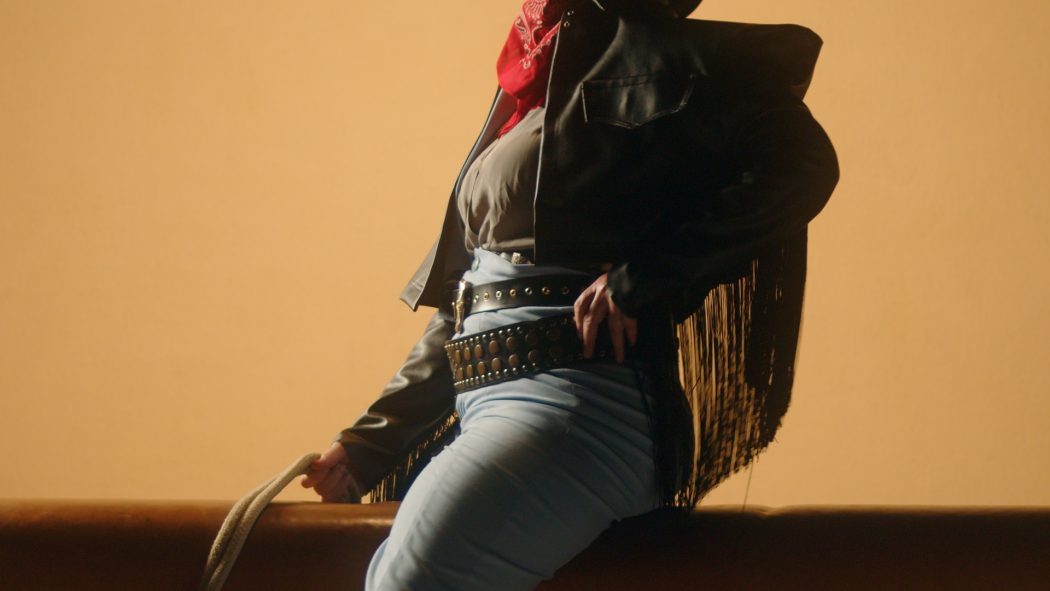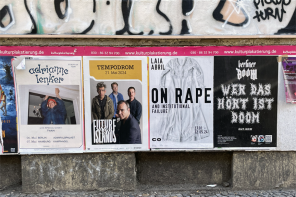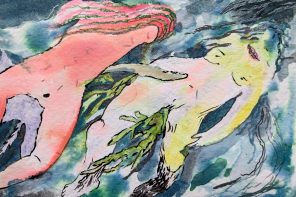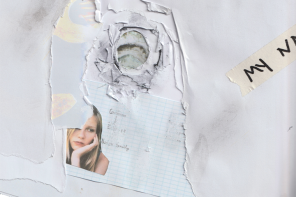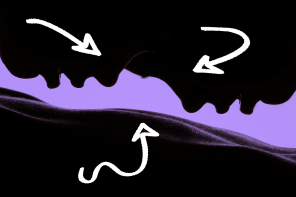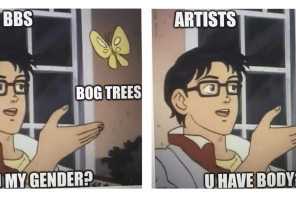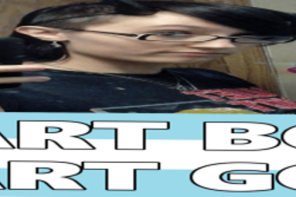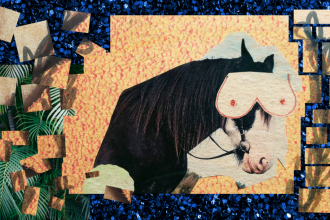Long-beloved by COVEN BERLIN since we began, artist and performer Melanie Jame Wolf opened her largest solo exhibition to date last October titled The Creep, curated by Adriana Tranca at E-WERK Luckenwalde. The Creep is composed of a film and immersive installation sprawling through a century-old former coal power station in southern Brandenberg. It takes from the Spaghetti Western genre to look critically—and cheekily—at the insidious creeping presence of everyday violence and fascism. It is sexy, witty, full of muscle, and totally eerie.
Here we talked about her show as she prepares for an artist talk with the curator and a performance on February 3rd.
Harley Agnes Aussoleil
Can we start by talking about the figure you embody in this piece: The Creep?
Melanie Jame Wolf
The Creep is both a persona in the film that features in the exhibition, and also the name of a broader phenomenon of things that creep – the interest of the show as a whole. There was the question for a long time in making this work: what gender is the outlaw figure in the film? What gender is The Creep? For me, he…they, almost probably he, emerges from a practice that I don’t necessarily call drag. I don’t know what else to call it, I’m looking for language other than ‘drag’. Like, in relation to a club-based drag practice where perhaps playing for entertainment or for laughs is an important driver, that’s not really what I’m going for here – even though humour is involved. I’m for sure very interested in camp and camp masculinities, but The Creep isn’t drag, they’re an inhabitation. They’re an inhabitation of a really murky kind of confluence of factors coming together that has to do with a fascination with masculinity born out of the circumstances that I grew up in – a very particular kind of white working class masculinity that I was surrounded by, submerged in. And also that I was working in a strip club for many, many years and existed in a space where straight cismen believe that they’re alone, that they’re in a men-only space where they behave according to that feeling of being outside a censoring gaze of ‘good behaviour’, that they are ‘alone with the boys’.
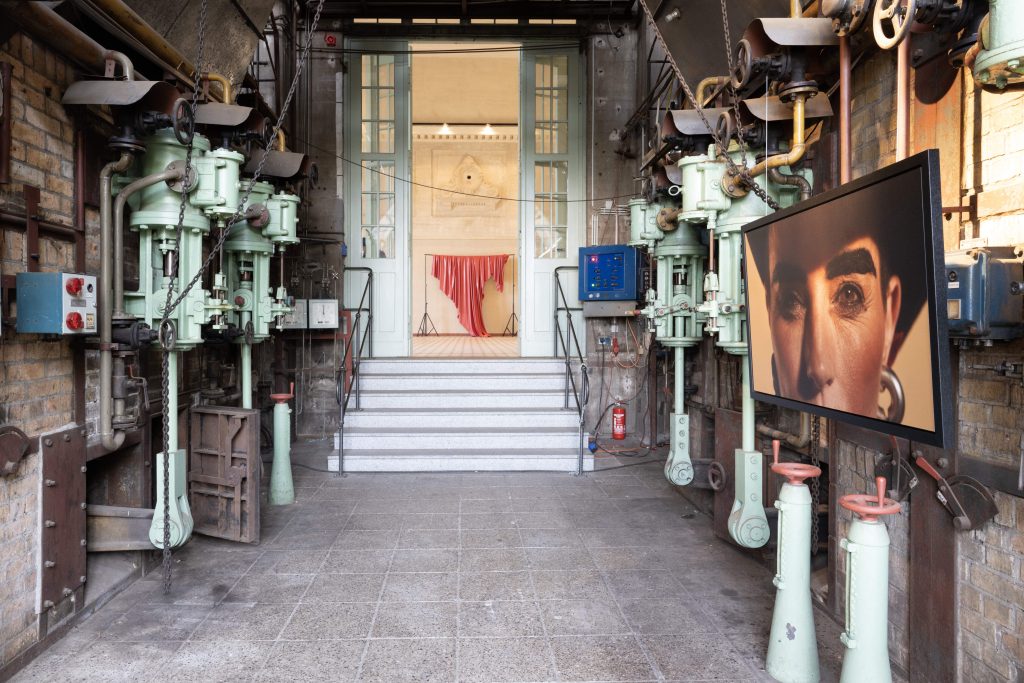
This summoning or inhabitation runs through my work. Acts of Improbable Genius with the comedian persona of Stand Up Ron is an example. There again is this exorcism or inhabitation of a variety of masculinities that I’ve encountered a lot, and my fascination with their erotics and their power— including the things about them that are repulsive. I’m not coming from a position where I hate men. Not at all. That’s not my feminism, so to speak. What I’m doing is a queer inhabitation in the sense that it is indeterminate, ambivalent, and ambiguous. Its edges, its surfaces are really porous. So it’s more to do with an interest in shapeshifting, and performance, and inhabiting masculinity to feel through its problems, and its pleasures, and invite people into a kind of uncanny encounter with that.
HAA
The refrain we keep getting from The Creep about what lies ‘there yonder’ evoked for me the manipulation of narrative, and therefore power, ranging in scale from within interpersonal relationships to broader abuses of the state all at once.
MJW
This is how power and oppression operate: through getting people on side with, or trapped under, narratives. Power and oppression creep through this process. I was interested in working specifically with the Hollywood genre of ‘The Western’ via the ‘Spaghetti Westerns’ popularized by Sergio Leone – an Italian director whose ‘Dollars Trilogy’ of films in the 1960s and 70s made Clint Eastwood famous. Spaghetti Westerns are a European imagining of the Hollywood imagining of the ‘Wild West’, so they are a kind of mise en abyme of increasingly camp fantasies of the colonial frontier, a particular cultural fantasy where a man can live and die ‘outside the law’. I’m curious about how this cinematic world is a pleasurable pop cultural space, while being saturated with personas, dynamics of oppression, and power that are densely problematic. It’s super operatic in a sense. Through a not unloving pastiche of the tropes, masculinities, and representations of violence – and more importantly the threat of violence – of the Leone films in The Creep, I’m invoking established or possibly familiar narratives, mythologies, and certain pop cultural sensibilities to question and evoke a kind of ambience of how violence and power move in a variety of contemporary contexts.
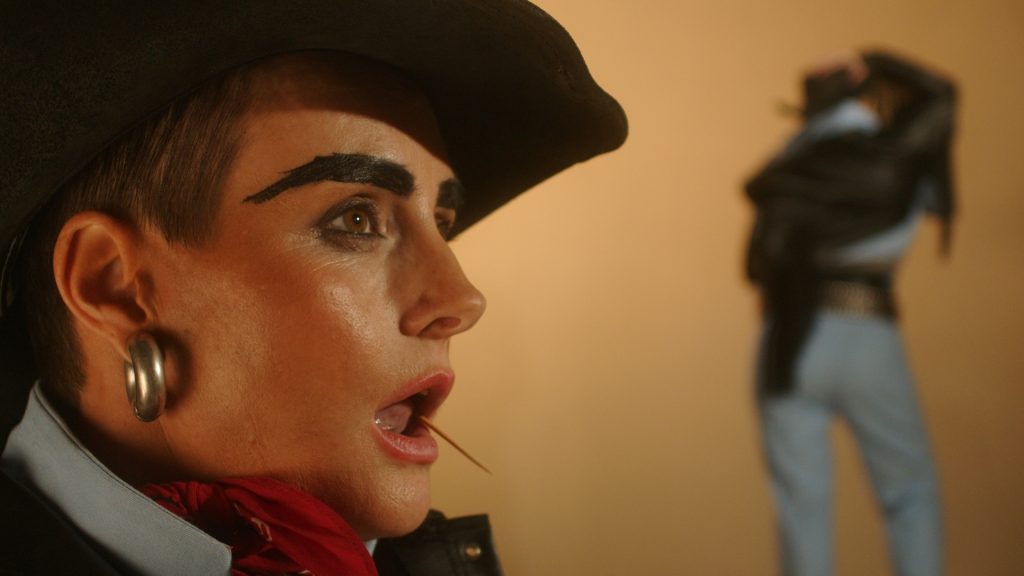
For example, I was thinking a lot about class violence – I’m often thinking about class violence – and how it moves so invisibly in the day to day; how it flares up and quakes and becomes an affective thing more than a quantifiable thing in effect. What I think The Creep is interested in as a work are things that are operating invisibly, subtly, imperceptibly on affective channels – so they’re hard to prove and hard to talk about, and how the veracity and verifiability of those hard to prove, hard to talk about things gets manipulated in all kinds of situations.
HAA
Can you talk about the role of humor in this work?
MJW
Humour is really important to me. It’s something I value greatly in life, and it falls naturally into my work. But it’s not like I go, “Yes, and then I will do something funny. I will now deploy humour.”, you know? There’s this saying: “it’s not funny if you have to explain it”, which is the thing about comedy — it’s hard to talk about humor in my work— but I’m using it all the time. I feel like it’s a really effective way to endear people to questions or subject areas that I’m exploring that they otherwise might not want to look at sombrely or directly. It’s a kind of charming/disarming sleight of hand. The economy of humor is based on taking a risk. You might know someone but you don’t realize they’re actually riotously hilarious for a couple of years, because it takes them that long to take that kind of risk in front of you – to risk that vulnerability, that potential failure, that delicious weirdness. And so I think when I use humor in the work – and this very much comes from my work as a performer over many years – it’s a tactic to dissolve the tension of a moment, or reorient a moment through. And so it’s risky. And because it’s risky, it’s sexy.
This might be the thing about The Creep for people who have this response of: “Oh, my God, The Creep is repulsive, but I also kinda wanna have sex with them.” Because being funny is hot. And it’s a slipperiness: is The Creep inherently funny? Or is our gaze making them funny? Are they a joker or are they a joke? You know, what does that distance do to them and how we understand them? Do we know them, or get them, or not? Like with the shoot-out sequence, as a pastiche of the Sergio Leone cinematic language, I wanted to make a clear choreographic motif of ‘conjuring of the invisible weapon’. You know, the fingers twitching, summoning at the hips, but there is in fact no weapon there. Like in classic Greek theater – the graphic violence is left outside of representation, it’s left to the imagination of the audience – which can produce infinite possibilities of horror. It’s also kind of a joke that the weapon inevitably doesn’t exist—like the punchline, the gag, is: maaaybe it’s the threat of projection that harms us?
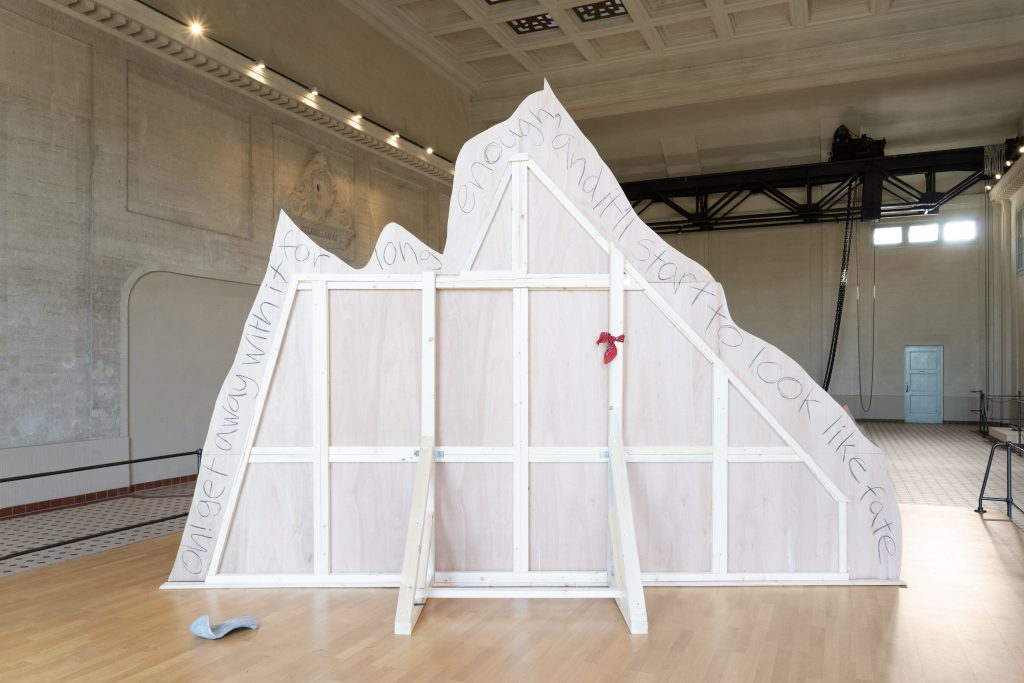
The mountains of the exhibition are another kind of visual gag on one level – they are a riff on theater flats, or the kind of Roadrunner/Wyle E. Coyote cartoon prop as an illusion of danger. The mountains in the exhibition are perhaps the briefest gesture that can be recognizable as a mountain – a quick line drawing: and as you approach the big one, it’s this – albeit two-dimensional – white, towering mountain. Then as you come to the side, you see just how incredibly thin it is. I think a joke is often a revelation – to be delighted by the discovery of something being shifty in its shape, by having a punchline, a plot twist, a big reveal – and this becomes a further seduction into the work. The aperture of wanting to engage widens receptivity and I think this is the thing: humor increases receptivity to what else I might want to talk about seriously in both subtle and obvious ways.
HAA
Can you talk about another sculptural part of the exhibition, the ceramic pink and blue tongues, and how you came up with their title?
MJW
They’re tongues that are independent of a body; I don’t really understand them as having been cut out or removed from a body. They’re independent. And they’re hard, solid objects. I wanted to sculpt them to have a lot of dynamism and a lot of movement because I’m interested in how objects might perform. In some way, this is as an ersatz for myself in my body and in the live moment, but also just letting the objects perform in the space over time. I call them Tongue Army Got You Licked to allude to the idea of the threat of a swarm – either as a physical reality or a mentality. Of course we think about the tongue as an essential thing, of how language is produced. But for anyone who’s been licked against their will, or had lips licked at them on the street by some unsolicited weirdo, the tongue is also repulsive, it can be a very violent thing in its wet muscley uncanny viscerality.
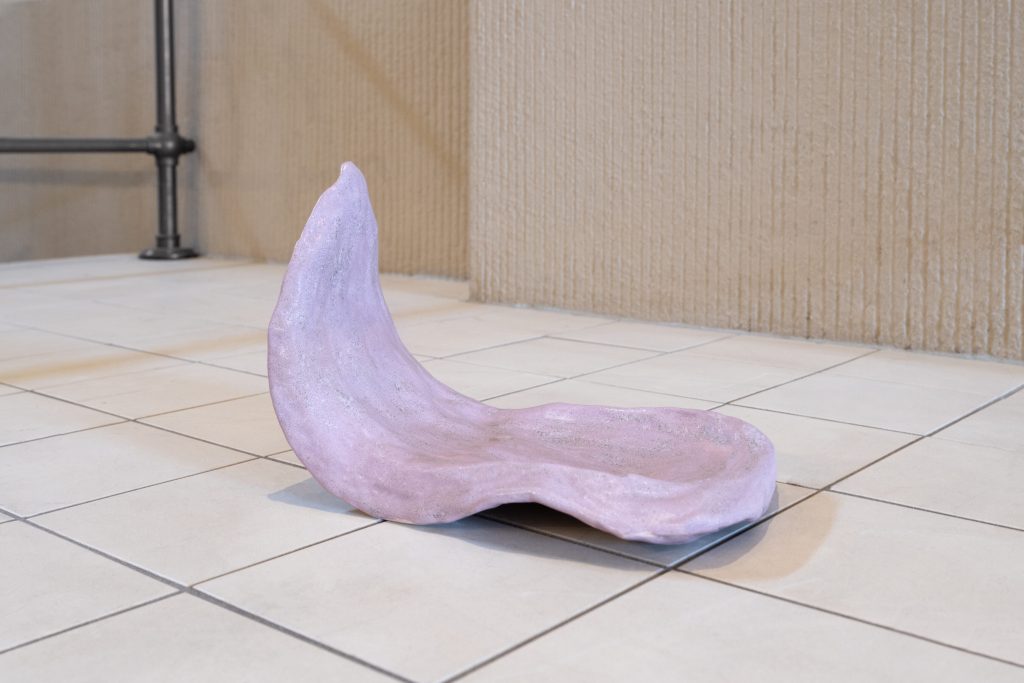
I keep coming back to this moment when my kid was two-and-a-half or three years old. We got on the bus and before I could get a handle on the moment, my kid had sat down next to someone and licked this person’s arm. The person whose arm they licked recoiled with such abject horror—it was just such a transgression! So I think Tongue Army is about the threat—getting back to this idea of the invisible and the insidious—and the harnessing of the threat. Tongue Army Got You Licked is an embodiment of the unwieldy threat that is always already there, but yet to pounce.
More concretely, If we only imagine fascism in some distant historical way in the European or ‘Western’ context – which is, of course, ahistorical – we fail to see that it’s already here now in insidious and not so insidious forms: as a contemporary, urgent reality. When you have the far-right AfD party reaching over 20% in polls in Germany, and not just in the assumed formerly east German states, but also in the western regions of Hessen, and in Bavaria, I think it’s much closer than many people like to think, and less ‘fringe’ and therefore something to be laughed off as a little gauche blot on the political landscape, than people would like to think. That mistake was also made with Trump, right? – that it was all a big impossible joke, until it wasn’t. And the reasons for the popularity of that kind of political representation for folks needs to be addressed through intersectional class analysis and locating ways for shifting the broader political imagination away from flirtations with the potent libidinal appeal of fascist power, not just sneered at as some regrettable, cringe anomaly of bad taste or lower income.
Fascism creeps. It creeps through narrative, through buffering a reckoning with violent realities – with actual broken bodies – by endlessly equivocating about the semiotics with which those acts of violence are framed. How do we define things like genocide or apartheid or fascism? What I see in dominant white European discourse right now, including what is called ‘the left’ is, first and foremost, a phenomenal amount of unexamined, unacknowledged, stubbornly dumb racism. And therefore gaping blindspots in comprehending what the problems are and why they should be of concern. And secondly, back to language, a kind of willfully naive faffing around with definitions so that it’s not really fascism until members of the white middle classes that you know personally are lined up against a wall, otherwise, it’s just ‘bemusing bad faith racist regional thuggery’ and until then, ‘don’t over dramatise. let’s be decent’. You know, the danger of this and how far down a ‘slippery slope’ people are willing to descend is not without grotesque precedent. The threat is in the room with us now, so to speak. Like a creep.
Watch the trailer for The Creep.
Words by Melanie Jame Wolf and Harley Agnes Aussoleil
Melanie Jame Wolf is a visual artist and choreographer who lives in Berlin. She works solo and with friends, making interdisciplinary pieces about power, flows of capital, and the pervasive phenomenon of ‘show business’ in theatrical, political, and everyday contexts. Coming from a background in contemporary performance, Melanie Jame works with text, sound, moving image, choreography, and sculpture. Her work often focuses on specific performance techniques, like impersonation, rehearsal, or stand up, understanding the body as an unruly political riddle. Leaning into a hyper-stylised pop aesthetic, she is invested in humour as a strategy for critical possibility, and in working with language in subliminal and surprising ways.
Harley Agnes Aussoleil is a curator and artist based in Berlin since 2012. She has been a member of COVEN BERLIN since 2016.

